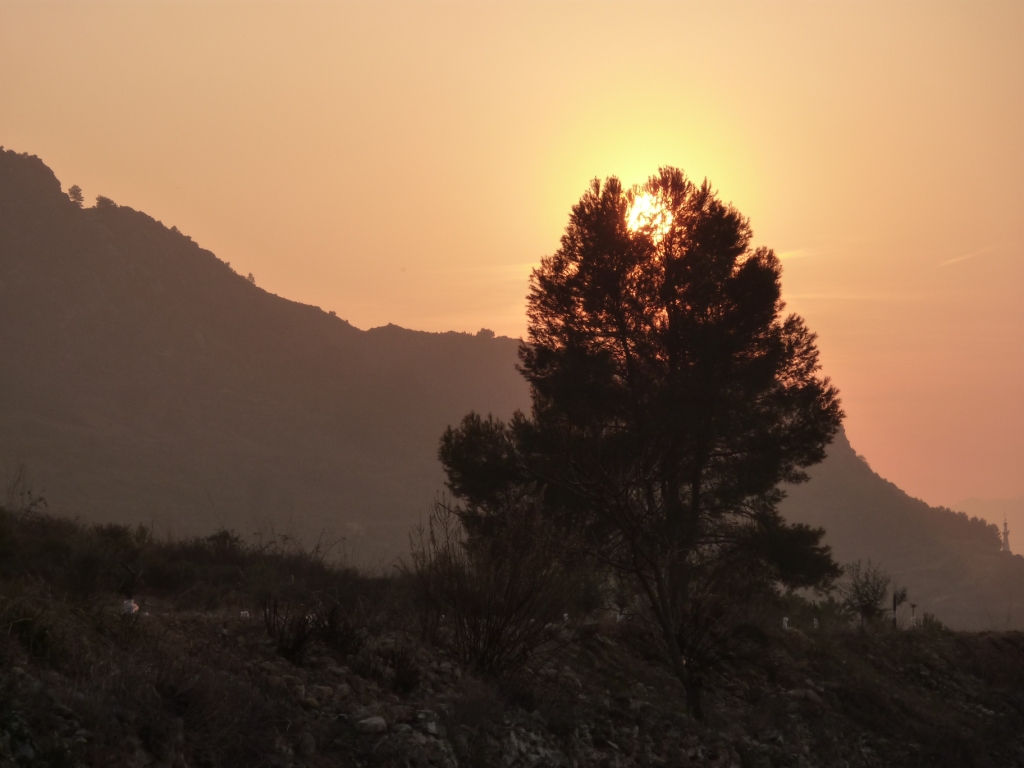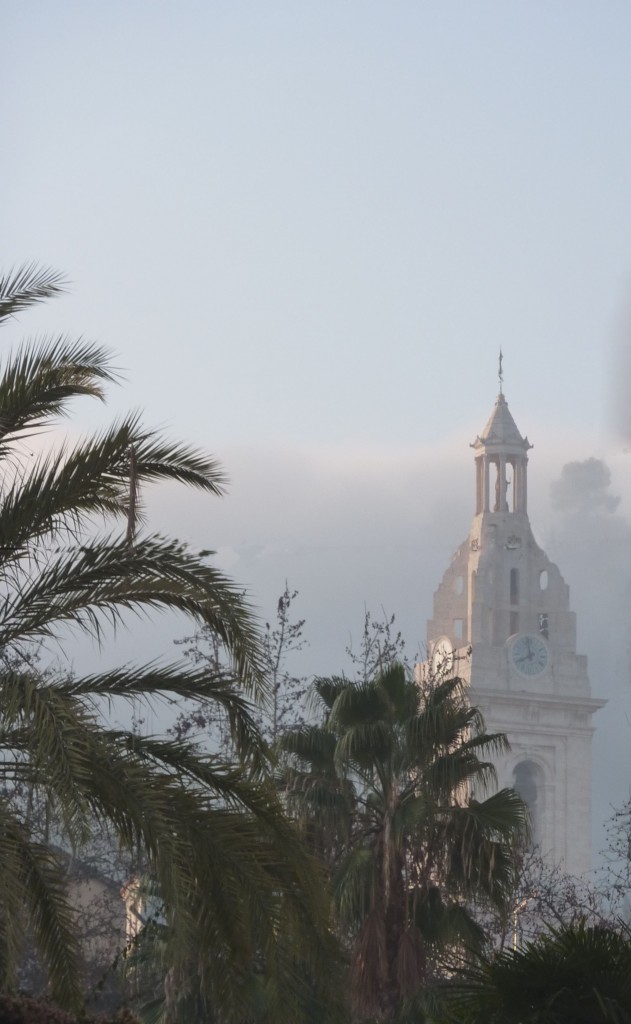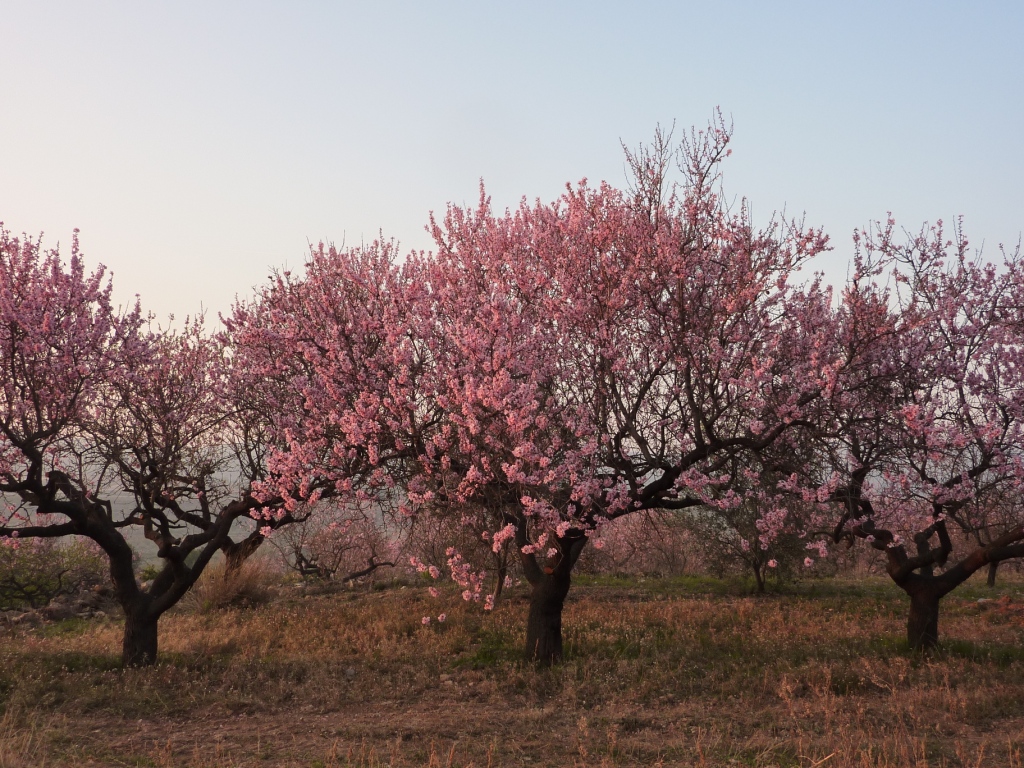Prayer: “Pray all the time”
The Way to Almansa
[mapsmarker layer=”12″]
My first post on the Camino de Levante told of how, on the second day of this Camino from Valencia to Santiago de Compostella I became aware of the presence of St. Theresa of Lisieux while I was walking through the orange groves. I sensed that this child-saint, known as “The Little Flower” seemed to be telling me to pray all the time. On my two previous Caminos I had prayed regularly: prayers of thanksgiving, mantras, the naming of family and friends. I prayed for Peace in the world and I carried with me the prayers from the Iona Community, which includes some psalms. I prayed for people I met and, most of all, I had learned that God speaks in silence. Put in a list like this it seems to me a lot of prayer but it was far from praying all the time. Also I’d followed Sadhana by Tony de Mello: a”Way of Prayer”. Anthony de Mello was a Jesuit who, after his death, was investigated by the Vatican who found that his “positions are incompatible with the Catholic faith and can cause grave harm.” This condemnation was made by Joseph Razinger who later became Pope and signed by Cardinal Bertone. I include this detail for historical interest since Tony de Mello’s works are widely used in Catholic circles today. Sadhana had opened up new horizons on prayer for me but, nonetheless, I still felt I was a novice at prayer. Appropriately, the route to Santiago from Valencia heads off South for the first two or three days whereas Santiago is in exactly the opposite direction. My prayer experience is often like that: I head in one direction and find myself being led in another.
The Camino de Levante offers fairly good stops for the pilgrim but these are not usually in albergues as on the Camino Francés. Generally, I had to go to the local police station where the key for a sports pavillion, community centre or doctor’s surgery was made available to those walking the Camino. It was important to have a sleeping mat as well as a sleeping bag. There was always a loo and a shower with hot water. I was moved by the generosity of the people on many occasions who seemed to accept that making a visitor as comfortable as possible was their only task for the day.
“Teach me how to pray”
I took this advice to pray all the time seriously and, in spite of Sadhana, I had to admit that I really didn’t have much idea about prayer. We are taught prayers as children and the Mass is a prayer. I had tried meditation and contemplating Gospel scenes using my imagination and senses. All this seemed fine, but I was faced with praying all the time, which suggested to me I needed more resources. So I simply prayed, “Teach me how to pray.” I added this as one of my prayers which I repeated over and over again. At this time, too, on my third day, the knee injury with which I had set off from Valencia began to give me pain. I remember taking this picture in the evening as I neared Xativa as the sun was about to set. I was in a good deal of pain when moving.
My knee had seized and I was walking at less than 1km/hour. I calculated I had 2 more hours of walking ahead. The day’s walking had given me plenty of beauty to delight in but now I had something “real” to pray about. The words, “Father, this is hurting me. I would very much like to do this pilgrimage but I can’t go on with this pain. Let it be your will not mine, in the end” echoed the prayer given to us by Jesus in Gethsemene. To make these words my own I needed detachment, genuine detachment from my desire to make this pilgrimage. So I hobbled into Xativa detached. I must have been very tired indeed because I remember being told that there was no lodging available and I have no recollection of where I slept that night. I recall taking this photo while leaving in the morning.
The rest is a blank including where I got hold of bread and sardines. I do know that my knee was not painful and I cautiously gave thanks for this and began seriously to try to pray all the time. It didn’t take too long to see that an awareness of God in everything I sense and everything I do is part of this prayer, at least in theory. I needed that to become a habit and indeed that day was so beautiful I didn’t feel too challenged. The orange groves were giving way to orchards and the sun was shining heating up the February morning.
At midday my knee began to hurt. I felt a thud of disappointment and alarm. I still had 10km to go to Moixent. So I again prayed the prayer of detachment and stopped for a hearty lunch of bread, fruit and sardines. My knee was none the better after the pause and, once again, I was notching up about a kilometre in an hour. I began to repeat, “Jesús, en tí confío.” It has a perfect rhythm to it, fitting in with a stab of pain as I weighed down on my knee, followed by a moment of relief with weight on the other foot. I began to speed up slightly and reached Moixent by nightfall. I was filled with gratitude and joy until the local policeman on duty told me that the lodging was in the Red Cross shelter over a kilometer away, uphill. I was tempted to sleep in the park but, having been entrusted with the key, I dragged myself there. This pattern of pain free mornings repeated itself for the next few days. I learned that the first 15 km were a gift, then would come the agony which was possible to survive by repeating my mantra. Meanwhile I was trying to pray all the time. As is common on the Caminos in Spain, all the churches are shut, so I used one to hang out my washing. Washing clothes is a contemplative task, I now know. Indeed, everything can be.
So I practised praying all the time. The essence of continuous prayer, seemed to me then, and seems to me now, to lie in Awareness (which is the title of another book by Tony de Mello Awareness pdf ). It is being aware of self, of others,of the surroundings and of God in all things. It is an attitude, a way of being. “Peace is every Step” is a Zen Buddhist approach to mindfulness which decribes what I was beginning to discover. This disposition was growing within me throughout the pilgrimage and still is. I can recall nearly all the places I slept after Xativa!!
There is much more I hope to write about praying all the time. I was beginning to change in the way I felt one with all my surroundings, the dusty camino, the herds of goats, the shadows and sombres, the wind…….everything. Being outside from early morning and all day helped me, together with this attitude of prayer which I was hoping to make part of me.
Gerald Manley Hopkins, another Jesuit, was steeped in Awareness and I recalled his famous poem:
Pied Beauty
Glory be to God for dappled things—
For skies of couple-colour as a brinded cow;
For rose-moles all in stipple upon trout that swim;
Fresh-firecoal chestnut-falls; finches’ wings;
Landscape plotted and pieced—fold, fallow, and plough;
And áll trádes, their gear and tackle and trim.
All things counter, original, spare, strange;
Whatever is fickle, freckled (who knows how?)
With swift, slow; sweet, sour; adazzle, dim;
He fathers-forth whose beauty is past change: Praise Him.
G.M. Hopkins
I couldn’t walk but I was free: I could pray as I liked in a million ways, through the stars and the fields and a million of things, with words, without words, walking, sitting and talking and a thesaurus of verbs: to be who I am, and to be with the other who is; to yell out in agony or shout the “Glory be to the Father” at the top of my voice. And listen to God in silence.







